
Cuerda seca (Spanish for "dry cord") is a technique used when applying coloured glazes to ceramic surfaces.

Cuerda seca (Spanish for "dry cord") is a technique used when applying coloured glazes to ceramic surfaces.
When different coloured glazes are applied to a ceramic surface, the glazes have a tendency to run together during the firing process. In the cuerda seca technique, the water-soluble glazes are separated on the surface by thin lines of a greasy substance to prevent them running out of their delineated areas. A dark pigment such as manganese carbonate is usually mixed with the grease to produce a dark line around each coloured area. [1]
Although some scholars have postulated a Timurid- Iranian origin, [2] many scholars believe that the cuerda seca technique originated primarily in al-Andalus (Islamic Spain and Portugal) in the second half of the 10th century, during the Umayyad period (citing Umayyad-era examples from Suza). [3] [4] [5] [6] The technique was further advanced during the Taifas period in the 11th century. [4] Preserved fragments of tiles from the late 12th-century minaret of the Kasbah Mosque in Marrakesh, Morocco, have been cited as the earliest surviving example of cuerda seca tilework being used for architectural decoration. [6]
In central Asia tiles were manufactured using the cuerda seca technique from the second half of the 14th century. [7] The introduction of different coloured glazes is recorded in the mausoleums of the Shah-i-Zinda necropolis in Samarkand. In the 1360s the colours were restricted to white, turquoise and cobalt blue but by 1386 the palette had been expanded to include yellow, light-green and unglazed red. [8] Large quantities of cuerda seca tiles were produced during the Timurid (1370–1507) and Safavid (1501–1736) periods. [9]
In the 15th century Persian potters from Tabriz introduced the technique into Turkey and were responsible for decorating the Yeşil Mosque in Bursa (1419-1424). [10] Within the Ottoman Empire cuerda seca tilework fell out of fashion in the 1550s and new imperial buildings were decorated with underglaze-painted tiles from İznik. The last building in Istanbul to include cuerda seca tilework was the Kara Ahmed Pasha Mosque which was designed in 1555 but only completed in 1572. [11] [12]

Tiles are usually thin, square or rectangular coverings manufactured from hard-wearing material such as ceramic, stone, metal, baked clay, or even glass. They are generally fixed in place in an array to cover roofs, floors, walls, edges, or other objects such as tabletops. Alternatively, tile can sometimes refer to similar units made from lightweight materials such as perlite, wood, and mineral wool, typically used for wall and ceiling applications. In another sense, a tile is a construction tile or similar object, such as rectangular counters used in playing games. The word is derived from the French word tuile, which is, in turn, from the Latin word tegula, meaning a roof tile composed of fired clay.

The Süleymaniye Mosque is an Ottoman imperial mosque located on the Third Hill of Istanbul, Turkey. The mosque was commissioned by Suleiman the Magnificent and designed by the imperial architect Mimar Sinan. An inscription specifies the foundation date as 1550 and the inauguration date as 1557, although work on the complex probably continued for a few years after this.
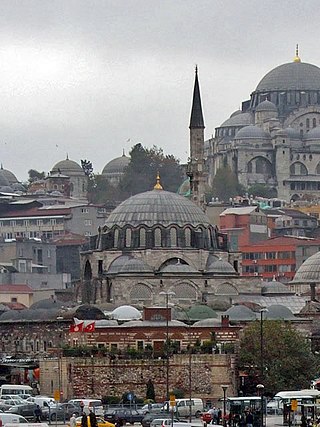
The Rüstem Pasha Mosque is an Ottoman mosque located in the Hasırcılar Çarşısı in the Tahtakale neighborhood of the Fatih district of Istanbul, Turkey, near the Spice Bazaar. Named after Rüstem Pasha, who served as Grand Vizier of the Ottoman Empire under Sultan Suleiman I, it was designed by the Ottoman imperial architect Mimar Sinan and completed in around 1563.

The Selimiye Mosque is an Ottoman imperial mosque, located in the city of Edirne, Turkey. It was commissioned by Sultan Selim II and was built by the imperial architect Mimar Sinan between 1568 and 1575. It was considered by Sinan to be his masterpiece and is one of the highest achievements of Islamic architecture as a whole and Ottoman architecture in particular.
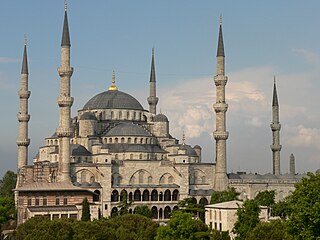
Ottoman architecture is an architectural style or tradition that developed under the Ottoman Empire over a long period, undergoing some significant changes during its history. It first emerged in northwestern Anatolia in the late 13th century and developed from earlier Seljuk Turkish architecture, with influences from Byzantine and Iranian architecture along with other architectural traditions in the Middle East. Early Ottoman architecture experimented with multiple building types over the course of the 13th to 15th centuries, progressively evolving into the classical Ottoman style of the 16th and 17th centuries. This style was a mixture of native Turkish tradition and influences from the Hagia Sophia, resulting in monumental mosque buildings focused around a high central dome with a varying number of semi-domes. The most important architect of the classical period is Mimar Sinan, whose major works include the Şehzade Mosque, Süleymaniye Mosque, and Selimiye Mosque. The second half of the 16th century also saw the apogee of certain decorative arts, most notably in the use of Iznik tiles.

The Eyüp Sultan Mosque is in the Eyüp district of Istanbul, outside the city walls and near the Golden Horn. The mosque complex includes a mausoleum marking the spot where Ebu Eyüp el-Ansari, the standard-bearer and companion of the Islamic prophet Muhammad, is said to have been buried. On a much older site, the present building dates from the beginning of the 19th century.

The Green Mosque, also known as the Mosque of Mehmed I, is a part of a larger complex on the east side of Bursa, Turkey, the former capital of the Ottoman Turks before they captured Constantinople in 1453. The complex consists of a mosque, a mausoleum known as the Green Tomb, a madrasa, a public kitchen, and a bathhouse. The name Green Mosque comes from its green and blue interior tile decorations. It is part of the historic UNESCO World Heritage Site.
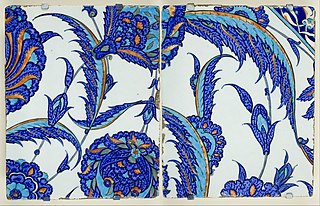
Iznik pottery, or Iznik ware, named after the town of İznik in Anatolia where it was made, is a decorated ceramic that was produced from the last quarter of the 15th century until the end of the 17th century. Turkish stylization is a reflection of Chinese Porcelain.
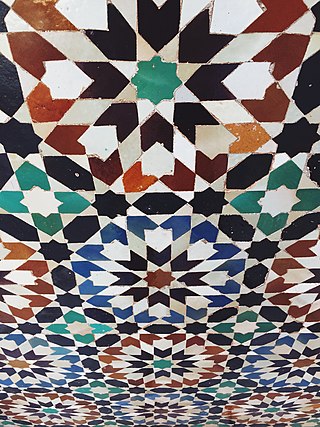
Zellij is a style of mosaic tilework made from individually hand-chiseled tile pieces. The pieces were typically of different colours and fitted together to form various patterns on the basis of tessellations, most notably elaborate Islamic geometric motifs such as radiating star patterns. This form of Islamic art is one of the main characteristics of architecture in the western Islamic world. It is found in the architecture of Morocco, the architecture of Algeria, early Islamic sites in Tunisia, and in the historic monuments of al-Andalus. From the 14th century onwards, zellij became a standard decorative element along lower walls, in fountains and pools, on minarets, and for the paving of floors.

Fritware, also known as stone-paste, is a type of pottery in which frit is added to clay to reduce its fusion temperature. The mixture may include quartz or other siliceous material. An organic compound such as gum or glue may be added for binding. The resulting mixture can be fired at a lower temperature than clay alone. A glaze is then applied on the surface.

The Şehzade Mosque is a 16th-century Ottoman imperial mosque located in the district of Fatih, on the third hill of Istanbul, Turkey. It was commissioned by Suleiman the Magnificent as a memorial to his son Şehzade Mehmed who died in 1543. It is sometimes referred to as the "Prince's Mosque" in English. The mosque was one of the earliest and most important works of architect Mimar Sinan and is one of the signature works of Classical Ottoman architecture.

The Tiled Kiosk is a pavilion set within the outer walls of Topkapı Palace and dates from 1472 as shown on the tile inscript above the main entrance. It was built by the Ottoman sultan Mehmed II as a pleasure palace or kiosk. It is located in the most outer parts of the palace, next to Gülhane Park. It was also called Glazed Kiosk.

The Yavuz Selim Mosque, also known as the Selim I Mosque and the Yavuz Sultan Selim Mosque is a 16th-century Ottoman imperial mosque located at the top of the 5th hill of Istanbul, Turkey, in the neighborhood of Çukurbostan, overlooking the Golden Horn. Its size and geographic position make it a familiar landmark on the Istanbul skyline.

Sokollu Mehmed Pasha Mosque is a 16th-century Ottoman mosque in the Kadırga neighborhood in Fatih district, Istanbul, Turkey. It was commissioned jointly by the grand vizier Sokollu Mehmed Pasha and his wife İsmihan Sultan. It was designed by the imperial architect Mimar Sinan and completed in 1571/2. The mosque is noted for the fine quality of the Iznik tiles that decorate the interior walls.

The Kara Ahmed Pasha Mosque or Gazi Ahmed Pasha Mosque is a 16th-century Ottoman mosque near the city walls in Istanbul, Turkey. It was designed by the imperial architect Mimar Sinan and completed in around 1572.

Miletus ware is a type of pottery that was produced in various locations in Anatolia between the late 14th and mid 15th centuries. The pottery type was excavated in quantity in the 1930s by Friedrich Sarre at Balat, Didim, ancient Miletus, hence the ware's name. It has long been realized that this pottery type was not produced at Balat, but in other towns such as İznik, the main centre, and Kütahya.

The Hadim Ibrahim Pasha Mosque is a 16th-century Ottoman mosque located in the Silivrikapi neighborhood of Istanbul, Turkey.

Behram Pasha Mosque is a 16th-century Ottoman mosque located in the town of Diyarbakır in southeast Turkey. It was commissioned by the Ottoman governor-general Behram Pasha.

The Muradiye Mosque is a 15th-century Ottoman mosque in Edirne, Turkey. The building is noted for the tiles that decorate the mihrab and the walls of the prayer hall.
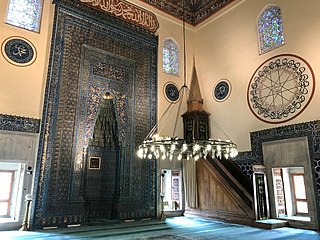
Early Ottoman architecture corresponds to the period of Ottoman architecture roughly up to the 15th century. This article covers the history of Ottoman architecture up to the end of Bayezid II's reign, prior to the advent of what is generally considered "classical" Ottoman architecture in the 16th century. Early Ottoman architecture was a continuation of earlier Seljuk and Beylik architecture while also incorporating local Byzantine influences. The new styles took shape in the capital cities of Bursa and Edirne as well as in other important early Ottoman cities such as Iznik. Three main types of structures predominated in this early period: single-domed mosques, "T-plan" buildings, and multi-domed buildings. Religious buildings were often part of larger charitable complexes (külliyes) that included other structures such as madrasas, hammams, tombs, and commercial establishments.